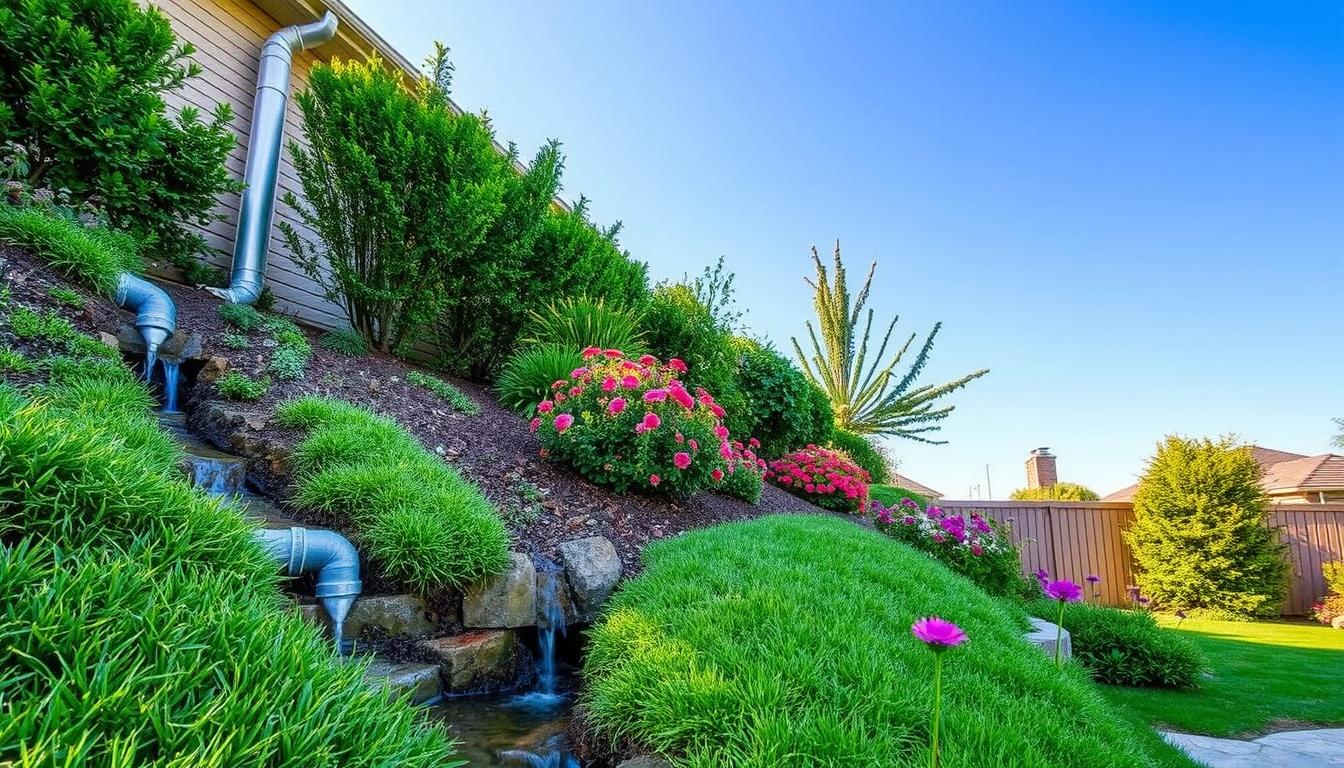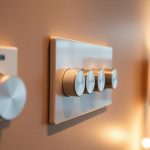Proper yard drainage is crucial to avoid water damage to homes and landscapes. Effective drainage systems and water management protect your property from excess water damage. A well-designed system redirects water away from your home, lowering the risk of foundation damage, erosion, and other issues.
Drainage systems and water management are key to yard maintenance. Understanding how to implement and maintain these systems ensures your yard stays safe and healthy.
Investing in a quality drainage system saves money and hassle over time. It prevents costly water damage repairs. With the right systems and strategies, you can have a beautiful, functional yard without water damage worries.
Key Takeaways
- Proper yard drainage is essential to prevent water damage
- Effective drainage systems and water management can protect your property
- A well-designed drainage system can redirect water away from your home
- Drainage systems and water management are critical components of yard maintenance
- Investing in a good drainage system can save you money and hassle in the long run
- Preventing water damage can help to reduce repair costs
Understanding Your Yard’s Water Problems
Many homeowners are unaware of the yard drainage issues caused by poor water management. A yard’s slope significantly influences water flow and drainage. This can lead to water pooling and erosion. Effective water management is essential to prevent these problems and protect your property.
To identify poor drainage signs, look for areas where water collects or flows unevenly. Factors like yard slope and obstacles like trees or gardens can cause this. Assessing your yard’s topography helps you understand water flow and where improvements are needed for better water management.
Common Signs of Poor Drainage
- Water pooling or standing water
- Erosion or soil degradation
- Uneven yard slope or grading
- Water damage to plants or structures
Recognizing these signs and taking action can improve your yard’s water management. This may involve adjusting your yard’s slope or grade, installing drainage systems, or using other techniques.
Impact of Water Damage on Property
Water damage can severely harm your property, causing structural damage, soil erosion, and lowering property value. Prioritizing effective water management and addressing yard slope and drainage issues is crucial. It helps protect your investment and keeps your property safe and secure.
The Science Behind Effective Drainage Solutions
Understanding hydrology is key to yard drainage. Runoff control is vital in managing yard water, preventing accumulation and damage. Proper flood prevention measures reduce water damage risks, ensuring a safe, healthy environment.
Effective drainage solutions rely on knowing how water moves through landscapes. Homeowners can manage yard water by installing French drains or using smart landscaping. Effective methods include:
- Installing surface drains to direct water away from the yard
- Implementing subsurface drainage systems to manage water beneath the surface
- Using natural drainage alternatives, such as rain gardens or swales
By using these methods, homeowners can manage yard water, preventing damage.
Effective drainage solutions need a comprehensive approach. They consider the yard’s topography, soil type, and water flow. Understanding the science behind drainage and implementing runoff control and flood prevention measures protects property, ensuring a safe, healthy environment.
| Drainage Method | Description | Benefits |
|---|---|---|
| Surface Drains | Direct water away from the yard | Effective for managing surface water |
| Subsurface Drains | Manage water beneath the surface | Helps prevent water accumulation and damage |
| Natural Drainage Alternatives | Use natural systems to manage water | Environmentally friendly and cost-effective |
Types of Professional Drainage Systems
Managing yard water effectively requires various professional drainage systems. These can be divided into surface, subsurface, and natural alternatives. Each type offers unique benefits and drawbacks, tailored to specific yard needs.
Surface Drainage Options
Swales and catch basins are surface drainage solutions. They collect and redirect yard water. Often paired with french drains, they provide a comprehensive drainage solution.
Subsurface Drainage Methods
Trench drains and perforated pipes are subsurface solutions. They collect water that seeps into the soil. Ideal for areas with heavy clay or water accumulation.
Natural Drainage Alternatives
Rain gardens and bioswales use plants and soil to filter water. These systems are eco-friendly and enhance yard aesthetics.
Understanding the various drainage systems helps homeowners manage yard water effectively. Whether it’s a surface, subsurface, or natural solution, there’s a system for every yard’s needs.
| Drainage System | Benefits | Drawbacks |
|---|---|---|
| French Drains | Effective at collecting and redirecting water | Can be expensive to install |
| Surface Drainage Options | Easy to install and maintain | May not be effective in areas with heavy rainfall |
| Subsurface Drainage Methods | Can be used in areas with heavy clay soils | May require professional installation |
French Drains: A Comprehensive Solution
When it comes to landscape drainage, french drains stand out as a top solution. They capture and redirect water, preventing damage and erosion. These systems are versatile, tackling both surface and subsurface water issues.
A french drain consists of a perforated pipe, gravel, and a geotextile fabric. The pipe is placed in a trench, surrounded by gravel, and wrapped in fabric. This setup allows water to flow freely, while preventing clogs. French drains are crucial for landscape drainage, keeping your yard dry and safe.
- Effective water management: French drains can capture and redirect large amounts of water, making them an ideal solution for yards with significant drainage issues.
- Low maintenance: French drains are designed to be self-cleaning, with the gravel and geotextile fabric working together to prevent clogs and ensure that water can flow freely.
- Long-lasting: When properly installed, french drains can last for many years, providing a long-term solution to drainage issues.
Installing a french drain protects your yard from water damage and erosion. It ensures your landscape drainage system works well. Whether you face a specific drainage problem or want to safeguard your yard, a french drain offers a comprehensive solution. It brings peace of mind and preserves your yard’s beauty.
Smart Landscaping for Better Water Management
Effective water management in yards is achievable through smart landscaping. Understanding the yard slope and implementing strategies to control runoff can prevent water damage. This approach also helps in creating a beautiful outdoor space.
Strategic Plant Selection
Choosing the right plants is key in managing yard water. Plants with deep roots can absorb water, reducing runoff and preventing erosion. Effective plants for water management include:
- Native grasses
- Groundcovers
- Trees with deep roots
Grading and Sloping Techniques
Grading and sloping the yard directs water away from the house, preventing accumulation. A gentle slope ensures water flows freely, avoiding collection in certain areas.
Hardscaping Considerations
Hardscaping features like patios, walkways, and retaining walls control runoff and prevent erosion. Incorporating these into the yard design creates a beautiful, functional outdoor space. It effectively manages water.
DIY Drainage Solutions for Homeowners
Effective water management is key to a healthy, safe yard. DIY drainage systems offer a simple, cost-effective solution. They are within reach for homeowners.
Some popular DIY drainage solutions include:
- Installing a French drain to redirect water away from the house
- Creating a swale to capture and filter rainwater
- Using permeable pavers to reduce stormwater runoff
When choosing a DIY drainage solution, consider your yard’s water management needs. Look at the slope, topography, soil type, and vegetation.
DIY drainage systems help homeowners manage yard water and prevent property damage. Always check local regulations and seek professional advice if needed.
| DIY Drainage Solution | Benefits |
|---|---|
| French Drain | Redirects water away from the house, reduces erosion |
| Swale | Captures and filters rainwater, reduces stormwater runoff |
| Permeable Pavers | Reduces stormwater runoff, allows for groundwater recharge |
Professional Installation vs. DIY: Making the Right Choice
Homeowners often face a dilemma when it comes to drainage systems: whether to hire professionals or tackle the job themselves. Each option has its advantages and disadvantages, influenced by factors like cost, time, and effort.
Cost is a significant factor. Professional installation might be pricier at first, but it often comes with a warranty. This ensures the job is done right, preventing future flood issues. DIY solutions, while cheaper, require more time and effort. There’s also a higher chance of errors or incomplete work.
When deciding between professional installation and DIY, consider these key factors:
- Cost: Professional installation can range from $3,000 to $10,000 or more, depending on the complexity of the project, while DIY solutions can cost between $500 to $2,000.
- Time and effort: Professional installation typically takes a few days to a week, while DIY solutions can take several weekends or even months to complete.
- Expertise: Professional installers have the necessary training and experience to ensure that drainage systems are installed correctly, while DIY enthusiasts may need to learn new skills or risk making mistakes.
In conclusion, the choice between professional installation and DIY drainage solutions depends on individual circumstances. If you value convenience, expertise, and a guarantee, professional installation may be the better option. On the other hand, if you’re on a tight budget and willing to invest time and effort, DIY solutions can be a viable alternative. It’s crucial to weigh the pros and cons carefully, considering cost, time, and expertise to make an informed decision about your drainage systems and flood prevention needs.
| Option | Cost | Time and Effort | Expertise |
|---|---|---|---|
| Professional Installation | $3,000 to $10,000+ | A few days to a week | High |
| DIY Solutions | $500 to $2,000 | Several weekends or months | Variable |
Maintenance Tips for Drainage Systems
Effective water management is vital for your landscape drainage system’s performance. Regular maintenance prevents clogs, backups, and other problems. By following simple tips, you can ensure your system works well and protects your property from water damage.
Seasonal care is crucial for your drainage system’s upkeep. Regular inspections can spot potential issues early. In spring, clean your gutters and downspouts. Summer is the time to check your yard’s grading to avoid water pooling. Fall brings another gutter and downspout cleaning. Winter might require freeze-proof faucets and insulated pipes to prevent freezing.
Seasonal Care Guidelines
- Inspect your gutters and downspouts regularly
- Check your yard’s grading to ensure proper water flow
- Clean your gutters and downspouts in the spring and fall
- Install freeze-proof faucets and insulate exposed pipes in the winter
By adhering to these guidelines and maintaining your system regularly, you ensure its effectiveness. This proactive approach prevents costly repairs and maintains a safe environment.
Troubleshooting Common Issues
Addressing drainage system problems promptly is crucial. Issues like clogs, backups, and slow drainage can be solved by checking gutters, ensuring proper yard grading, and using a plumber’s snake for clogs.
| Issue | Cause | Solution |
|---|---|---|
| Clogs | Debris in gutters and downspouts | Check and clean gutters and downspouts regularly |
| Backups | Improper yard grading | Ensure yard is graded properly to prevent water accumulation |
| Slow drainage | Clogs or blockages in pipes | Use a plumber’s snake to clear clogs and blockages |
Innovative Water Management Technologies
As we face the ongoing challenges of flood prevention and effective drainage systems, innovative water management technologies are gaining importance. Advanced materials and systems are being developed to enhance the efficiency and effectiveness of drainage systems. This reduces the risk of flooding and water damage.
Recent innovations in water management technologies include:
- Smart drainage systems that can detect and respond to changes in water levels
- Advanced materials that can absorb and filter water, reducing the risk of flooding
- Green infrastructure solutions that use natural systems to manage water
These cutting-edge technologies have the potential to transform how we manage water and prevent flooding. By integrating drainage systems and flood prevention measures into our water management strategies, we can lower the risk of water damage. This creates safer, more sustainable communities.
It is crucial to continue investing in research and development of innovative water management technologies. By doing so, we can stay ahead of the challenges posed by flooding and water damage. This will help us create a more sustainable future for generations to come.
| Technology | Description | Benefits |
|---|---|---|
| Smart Drainage Systems | Systems that can detect and respond to changes in water levels | Improved efficiency, reduced risk of flooding |
| Advanced Materials | Materials that can absorb and filter water | Reduced risk of flooding, improved water quality |
| Green Infrastructure | Natural systems used to manage water | Improved water quality, reduced risk of flooding |
Legal Considerations and Permits
Installing drainage systems involves legal aspects and permits. Homeowners must grasp local regulations and ordinances for water management projects. This knowledge is crucial.
Before beginning, you must research and secure necessary permits. These may include excavation, plumbing, and electrical permits. Without them, you face fines, penalties, and legal consequences.
Local Regulations
Local rules differ, but most cities have specific guidelines for drainage systems and water management. These regulations often cover:
- Permitting and inspection
- Design and installation standards
- Environmental impact assessments
- Neighbor notification and approval
Environmental Compliance
Your project must also adhere to environmental standards. This includes:
Compliance with the Clean Water Act and other federal regulations
Neighbor Considerations
Consider your project’s impact on neighbors. This involves:
Notification and approval from adjacent property owners
Protection of neighboring properties from erosion and water damage
Maintenance and upkeep of shared drainage systems
| Regulation | Description |
|---|---|
| Local Ordinances | Govern drainage systems and water management projects |
| Environmental Regulations | Protect wetlands, waterways, and prevent erosion |
| Neighbor Considerations | Notification, approval, and protection of adjacent properties |
Conclusion: Protecting Your Property Through Smart Drainage
Effective drainage solutions are key to safeguarding your property from water damage. Understanding the science behind water management and exploring drainage options helps homeowners protect their investments. This ensures the long-term value of their properties.
Whether opting for a professional-grade system or DIY solutions, addressing yard water problems is essential. Installing French drains and landscaping strategically are just a few options. By staying informed and taking action, you can avoid costly repairs. This keeps your property dry, safe, and structurally sound for years.
Investing in a well-designed drainage system is more than solving immediate problems. It’s about securing your home’s future. Making smart choices now brings peace of mind, knowing your property is protected against nature’s unpredictability. Take the necessary steps to manage your yard’s water challenges. This way, you can take pride in the long-term security of your most valuable asset – your home.


